3DTOPO
Hazard to Self
 
Posts: 64
Registered: 14-2-2016
Member Is Offline
Mood: No Mood
|
|
Ferrobronze?
Yesterday I poured some stainless steel and ran short, so I melted some mild steel and added like 30-40% copper.
It seems to have made a beautiful ferrobronze alloy. Only, is that a thing? Wikipedia does not have anything like this listed under ferro-alloys.
By question is, any metallurgists out there, what do I have? Is it a decent alloy (seems like it)? Do you think it will be stainless? I know that the
definition of "Stainless steel" specifies a minimum chromium content, but will it act like stainless with sufficient copper?
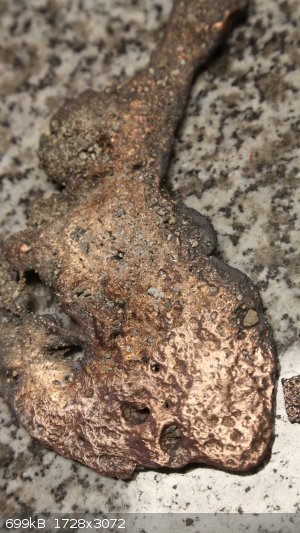
|
|
|
3DTOPO
Hazard to Self
 
Posts: 64
Registered: 14-2-2016
Member Is Offline
Mood: No Mood
|
|
Here's what I was making - it was going to be 2 pours (copper then stainless) but became 3 copper, stainless then ferrobronze. Just messing around
trying new things and learning. 
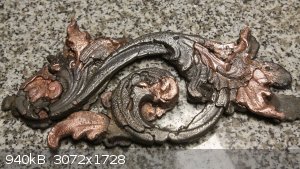
|
|
|
MeshPL
Hazard to Others
  
Posts: 329
Registered: 20-4-2015
Location: Universe
Member Is Offline
Mood: No Mood
|
|
The problem is, this are the impurities like copper or carbon, that speed up the corrosion of iron. What you just did is you put a ton of copper,
which will happily act as a cathode during electrochemical oxidation of iron. Copper by itself is not stainless, it forms patina, which, unlike rust,
is relatively non-porous and adherent, so that copper can be used in more demanding condition, than mild steel, but still oxidises. Iron forms a mess
of hydrated oxides, which flake off and allow further oxidation. However chromium used in stainless steel forms a thin layer of Cr2O3, which is thin,
adherent and remarkably inert.
I guess you need to test whether your alloy is corrosion resistant or not, but I wouldn't expect any degree of stainlessness, just a layer of stable
oxide, at most.
Nice metalworking, btw. Also, when testing usethe whole ingot made of one alloy, because any piece of other alloy attached will influence results
acting as anode or cathode. A quick way to test is to cover the piece with thin layer of salt solution. Iron oxidises that way nearly instantly,
although the oxide layer produced is relatively thin.
[Edited on 24-4-2016 by MeshPL]
|
|
|
Fulmen
International Hazard
    
Posts: 1693
Registered: 24-9-2005
Member Is Offline
Mood: Bored
|
|
There are copper alloys with small percentages of iron, and steels with small amounts of copper. But I can't find anything on Cu/Fe-alloys in this
range except for master alloys, so it doesn't appear to have any special or useful properties that can't be achieved with simpler or cheaper alloys.
We're not banging rocks together here. We know how to put a man back together.
|
|
|
unionised
International Hazard
    
Posts: 5102
Registered: 1-11-2003
Location: UK
Member Is Offline
Mood: No Mood
|
|
Given that both copper and iron are widely used, if there was anything much to be said fro a copper/iron alloy, I think we would know about it by now.
On the other hand, Stainless steel has chromium and nickel in it.
Copper alloys with those two metals are well known.
So that mixture might be interesting (or it might be totally useless).
|
|
|
argyrium
Hazard to Others
  
Posts: 123
Registered: 3-2-2008
Location: Pacific
Member Is Offline
Mood: No Mood
|
|
This reminds me of a puzzle from a few years ago. A client had asked me to re-do portions of patina on a full size cast bronze dog. It was a seated
dog on an octagonal base - attached by steel (badly rusted) bolts that projected from the underside of the dog through the base mount.
The entire piece was ferromagnetic. You can see a rare earth magnet stuck on several areas in the photos. At first I suspected there was steel
armature inside the casting but not so; the whole piece was uniformly magnetic.
I drilled a small area to sample and dissolved some turnings in HNO3. It drilled and filed and behaved like ordinary Cu/Sn bronze - dissolved as
expected in the acid.
Aside from reacting some of the dilute sol. w/ NH4OH and getting the expected tetraamino blue - thats as far as I investigated. The piece is probably
Italian from ~ turn of the century.
I'd never heard of "magnetic" bronze before. There was nothing unusual about the natural patina on unexposed areas but some areas on the exposed
surface did appear "rust" stained.
Would love to hear from others about this mystery alloy.
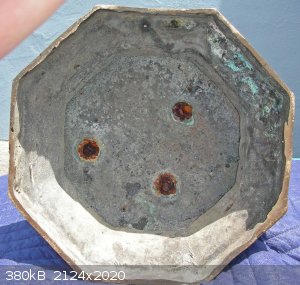 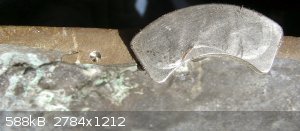 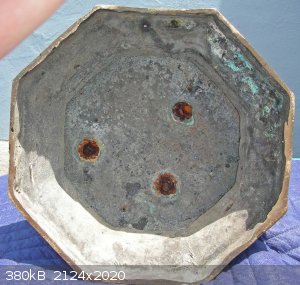 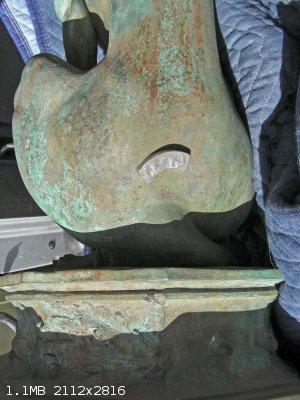
|
|
|
3DTOPO
Hazard to Self
 
Posts: 64
Registered: 14-2-2016
Member Is Offline
Mood: No Mood
|
|
Quote: Originally posted by MeshPL  | The problem is, this are the impurities like copper or carbon, that speed up the corrosion of iron. What you just did is you put a ton of copper,
which will happily act as a cathode during electrochemical oxidation of iron. Copper by itself is not stainless, it forms patina, which, unlike rust,
is relatively non-porous and adherent, so that copper can be used in more demanding condition, than mild steel, but still oxidises. Iron forms a mess
of hydrated oxides, which flake off and allow further oxidation. However chromium used in stainless steel forms a thin layer of Cr2O3, which is thin,
adherent and remarkably inert.
I guess you need to test whether your alloy is corrosion resistant or not, but I wouldn't expect any degree of stainlessness, just a layer of stable
oxide, at most.
[Edited on 24-4-2016 by MeshPL] |
Thank you for the information. If I had formed my question better, I would have asked: “..would [“ferrobronze”] form an stable adherent oxide
layer?”.
I have started some testing on the material; I guess I just wonder what the long term implications are - would it weather better than mild steel say
100 or 1000 years from now.
Quote: Originally posted by MeshPL  |
Nice metalworking, btw. Also, when testing usethe whole ingot made of one alloy, because any piece of other alloy attached will influence results
acting as anode or cathode. A quick way to test is to cover the piece with thin layer of salt solution. Iron oxidises that way nearly instantly,
although the oxide layer produced is relatively thin.
[Edited on 24-4-2016 by MeshPL] |
Thank you kindly! Attached is a image of same the pattern all poured in one shot with “ferrobronze”. I love how the coloring; where I want it more
yellow/copper to come out I just had to buff it a little more with a wire brush.
Just been messing around with sand - will get back to investment casting here real soon. 
And thanks - I started accelerated weathering on it - I got it wet and salty. Will do that a few times a day.
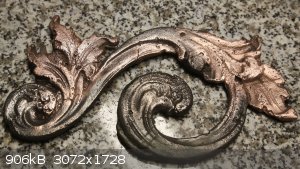
|
|
|
3DTOPO
Hazard to Self
 
Posts: 64
Registered: 14-2-2016
Member Is Offline
Mood: No Mood
|
|
Quote: Originally posted by Fulmen  | | There are copper alloys with small percentages of iron, and steels with small amounts of copper. But I can't find anything on Cu/Fe-alloys in this
range except for master alloys, so it doesn't appear to have any special or useful properties that can't be achieved with simpler or cheaper alloys.
|
I might be able to argue that point. If this alloy's inertness performs similar (or even superior) to stainless steel or bronze, then it might be
possible (and more readily available) to make it for less than what I would have to pay for stainless steel or bronze ingots to be delivered here.
Where I live, there is an abundance of mild steel, aluminum and copper scrap (in that order). There isn't much (if any) tin, bronze or an appreciable
amount of stainless steel at the dump pile.
So if I can mix some copper with mild steel to make something beautiful (that might even take a patina) and perform similarly to bronze, I think that
is amazing! Not to mention that ~30% copper in my tests is a lot less copper than is typically in bronze, so it should cost less per pound even paying
for raw materials.
In small quantities, bronze and stainless ingots can be insanely expensive per pound. Mild steel and copper - not so much. 
|
|
|
3DTOPO
Hazard to Self
 
Posts: 64
Registered: 14-2-2016
Member Is Offline
Mood: No Mood
|
|
Quote: Originally posted by argyrium  | This reminds me of a puzzle from a few years ago. A client had asked me to re-do portions of patina on a full size cast bronze dog. It was a seated
dog on an octagonal base - attached by steel (badly rusted) bolts that projected from the underside of the dog through the base mount.
The entire piece was ferromagnetic. You can see a rare earth magnet stuck on several areas in the photos. At first I suspected there was steel
armature inside the casting but not so; the whole piece was uniformly magnetic.
I drilled a small area to sample and dissolved some turnings in HNO3. It drilled and filed and behaved like ordinary Cu/Sn bronze - dissolved as
expected in the acid.
Aside from reacting some of the dilute sol. w/ NH4OH and getting the expected tetraamino blue - thats as far as I investigated. The piece is probably
Italian from ~ turn of the century.
I'd never heard of "magnetic" bronze before. There was nothing unusual about the natural patina on unexposed areas but some areas on the exposed
surface did appear "rust" stained.
Would love to hear from others about this mystery alloy.
|
Interesting, and thanks for sharing! What a wonderfully unique and beautiful patina at that.
Where you drilled some shavings, it looks practically identical to what I have here - and of course its magnetic too.
|
|
|
Texium
|
Thread Moved
22-11-2023 at 20:17 |